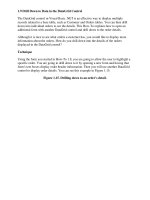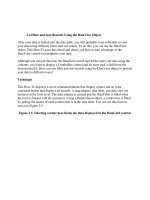Tài liệu Diabetes & Women’s Health Across the Life Stages ppt
Bạn đang xem bản rút gọn của tài liệu. Xem và tải ngay bản đầy đủ của tài liệu tại đây (298.15 KB, 8 trang )
&
Diabetes
Women’s Health
Life
Stages
Across the
A
Public
Health
Perspective
DEPARTMENT OF HEALTH
AND HUMAN SER
AND HUMAN SER
VICES
Centers for Disease Control and Prevention
Centers
for Disease Control and Prevention
MessMess
MessMess
Mess
aa
aa
a
ge frge fr
ge frge fr
ge fr
omom
omom
om
Frank VFrank V
Frank VFrank V
Frank V
inicor, MD, MPHinicor, MD, MPH
inicor, MD, MPHinicor, MD, MPH
inicor, MD, MPH
DirectDirect
DirectDirect
Direct
or, CDC Diabetes Pror, CDC Diabetes Pr
or, CDC Diabetes Pror, CDC Diabetes Pr
or, CDC Diabetes Pr
ogramogram
ogramogram
ogram
Writing this monograph has been important for many reasons for the diabetes
program at the Centers for Disease Control and Prevention (CDC). More than
just a “report,” it has become a model of thought, interaction, and commitment
to make a difference in the lives of people—women or men—facing the daily
challenges of diabetes.
We have come to better understand the impact of greater societal forces and
policies on the lives of people with diabetes, though individuals and health care
providers make their own essential contributions. Many cultural, social, organi-
zational, and environmental forces facilitate or limit the impact of our indi-
vidual decisions, and the need to coordinate science and clinical medicine with
programs and policies has become much more obvious to us.
CDC and many partners plan to convert the ideas in this monograph into
concrete action. Our goal is to augment programs to both prevent diabetes and
improve care for those with the disease. This will synergistically blend clinical
and public health strategies. CDC and its primary cosponsors, the American
Diabetes Association, the American Public Health Association, and the Asso-
ciation of State and Territorial Health Officials, will convene a national call-to-
action meeting to develop and then implement the
National Public Health
Action Plan for Diabetes and Women.
Much more work is required, but with
the monograph,
Diabetes and Women’s Health Across the Life Stages: A Public
Health Perspective,
the process has begun.
DEPARTMENT OF HEALTH AND HUMAN SERVICES
CENTERS FOR DISEASE CONTROL AND PREVENTION
SAFER • HEALTHIER • PEOPLE™
Diabetes
TM
Diabetes and WDiabetes and W
Diabetes and WDiabetes and W
Diabetes and W
omen’omen’
omen’omen’
omen’
s Health As Health A
s Health As Health A
s Health A
crcr
crcr
cr
oss the Life Soss the Life S
oss the Life Soss the Life S
oss the Life S
tt
tt
t
aa
aa
a
ges:ges:
ges:ges:
ges:
A Public Health Perspective
Diabetes is a serious health condition that affects women in all life stages. It is unique to women because it
can affect the health of both a mother and her unborn children. With the increasing life span of women and
the rapid growth of minority populations in the United States, the number of women at high risk for
diabetes and its complications will continue to increase. This will place added demands on the health care
delivery system.
Diabetes and Women’s Health Across the Life Stages: A Public Health Perspective
examines the challenges and risks of diabetes in each stage of a woman’s life.
Of the 15.7 million people with diabetes in the United States, more than half (8.1 million) are women.
Minority racial and ethnic groups are the hardest hit by type 2 diabetes; the prevalence is at least 2-4
times higher among black, Hispanic, American Indian, and Asian Pacific Islander women than among
white women.
About 90 to 95 percent of women with diabetes have type 2 diabetes (formerly called adult-onset).
Type 2 diabetes usually develops after age 40 and occurs when the body’s cells become resistant to
insulin. Insulin is a hormone secreted by the pancreas that allows glucose (sugar) to enter the body’s cells
and be converted to energy. Type 1 diabetes (formerly called juvenile-onset) occurs because the pancreas
makes little or no insulin.
The risk of heart disease, the most common complication of diabetes, is more serious among women than
men. Among people with diabetes who have had a heart attack, women have lower survival rates
and a poorer quality of life than men.
Children exposed to diabetes in the womb have a greater likelihood of becoming obese during childhood
and adolescence and for developing type 2 diabetes, later in life.
Women with diabetes have a shorter life expectancy than women without diabetes, and women are at
greater risk of blindness from diabetes than men.
Social, economic, and political barriers sometimes block high-quality care and easy access to health care
for women with diabetes.
Social and economic issues will leave many older women with diabetes living alone and poor.
Poverty is also a major concern for women of childbearing age who have diabetes.
All parts of society—public and private—have a role in addressing the public health issues of reducing the
burden of diabetes among women.
DEPARTMENT OF HEALTH AND HUMAN SERVICES
CENTERS FOR DISEASE CONTROL AND PREVENTION
SAFER • HEALTHIER • PEOPLE™
1-877-CDC-DIAB www.cdc.gov/diabetes
Diabetes
TM
The Adolescent Years (10-17)
Diabetes and WDiabetes and W
Diabetes and WDiabetes and W
Diabetes and W
omen’omen’
omen’omen’
omen’
s Health As Health A
s Health As Health A
s Health A
crcr
crcr
cr
oss the Life Soss the Life S
oss the Life Soss the Life S
oss the Life S
tt
tt
t
aa
aa
a
ges:ges:
ges:ges:
ges:
A Public Health PerspectiveA Public Health Perspective
A Public Health PerspectiveA Public Health Perspective
A Public Health Perspective
Most adolescents aged 10-19 years with diabetes have type 1, an autoimmune form of the disease in
which the pancreas produces little or no insulin. Without insulin, fat and sugar remain in the blood and
eventually can damage vital organs.
Acute complications such as ketoacidosis (acid buildup in the blood) or hypoglycemia (extremely low
blood sugar) are more common than chronic complications among adolescent girls with type 1 diabetes.
The rate of death among girls with type 1 diabetes is nearly 5 times greater than the general
population of girls aged 10-17 years.
About 61,500 girls younger than 20 years have type 1 diabetes; 92 percent are white, 4 percent are black,
and 4 percent are Hispanic or Asian American.
By age 20, 40 percent to 60 percent of people with diabetes have retinopathy, or diabetic eye
disease. Retinopathy can lead to blindness if untreated. The risk to develop proliferative retinopathy—
the most severe form—is higher for girls.
Current evidence suggests that eating disorders may be significantly higher among young women with
type 1 diabetes than among young women in the general population.
The incidence of type 2 diabetes appears to be increasing among both girls and boys, particularly in some
racial and ethnic minority groups. Formerly called adult-onset diabetes, type 2 diabetes usually develops
after age 40. Unlike type 1, type 2 diabetes is linked to obesity and physical inactivity and occurs when
the body loses its ability to use insulin. Complications from type 2 closely resemble those associated with
type 1 diabetes.
The increased prevalence of obesity among adolescent girls may play a role in the 10-fold increase in
type 2 diabetes among adolescents in the 1990s.
Physical and mental changes during puberty make diabetes management and control harder.
DEPARTMENT OF HEALTH AND HUMAN SERVICES
CENTERS FOR DISEASE CONTROL AND PREVENTION
SAFER • HEALTHIER • PEOPLE™
1-877-CDC-DIAB www.cdc.gov/diabetes
Diabetes
TM
The Reproductive Years (18-44)
Diabetes and WDiabetes and W
Diabetes and WDiabetes and W
Diabetes and W
omen’omen’
omen’omen’
omen’
s Health As Health A
s Health As Health A
s Health A
crcr
crcr
cr
oss the Life Soss the Life S
oss the Life Soss the Life S
oss the Life S
tt
tt
t
aa
aa
a
ges:ges:
ges:ges:
ges:
A Public Health PerspectiveA Public Health Perspective
A Public Health PerspectiveA Public Health Perspective
A Public Health Perspective
From 1990 to 1998, diabetes rates increased 70 percent for women aged 30-39 years.
Death rates for women aged 25-44 years with diabetes are more than 3 times the rate for women
without diabetes.
About 1.85 million women of reproductive age (18-44 years) have diabetes; about 500,000 of them do
not know they have the disease. Women of minority racial and ethnic origins are 2-3 times more likely
than non-Hispanic white women to have type 2 diabetes.
Type 2 diabetes accounts for most diabetes cases identified during this life stage. Most women with type
1 diabetes were diagnosed during childhood or adolescence.
Reproductive-aged women with type 2 diabetes have fewer years of education, lower incomes,
and are less likely than women without diabetes to be employed.
Between 2.5 percent and 4 percent of women in the United States develop gestational diabetes during
pregnancy. This type of diabetes results from the body’s resistance to the action of insulin. The increased
resistance during pregnancy is caused by hormones produced in the placenta (the cord that connects
mother and baby).
Gestational diabetes usually ends after the baby is born, but women with gestational diabetes have up
to a 45 percent risk of recurrence with the next pregnancy and up to a 63 percent risk of
developing type 2 diabetes later in life.
Although expectant mothers with diabetes can and do have normal, healthy pregnancies and deliveries,
they are at greater risk for complications such as preeclampsia (a toxic condition in late pregnancy that
causes a sudden rise in blood pressure, weight gain and swelling), Cesarean section, and infections.
Increasing numbers of women, especially nonwhite women, are at risk of having pregnancies complicated
by diabetes. American Indian women have considerably higher rates of gestational diabetes than the
national average. For instance, the prevalence for Zuni Indian mothers is 15.1 percent and for Navajo
Indian women, the rate is 10.4 percent among mothers aged 30-39 years.
DEPARTMENT OF HEALTH AND HUMAN SERVICES
CENTERS FOR DISEASE CONTROL AND PREVENTION
SAFER • HEALTHIER • PEOPLE™
1-877-CDC-DIAB www.cdc.gov/diabetes
Diabetes
TM
The Middle Years (45-64)
Diabetes and WDiabetes and W
Diabetes and WDiabetes and W
Diabetes and W
omen’omen’
omen’omen’
omen’
s Health As Health A
s Health As Health A
s Health A
crcr
crcr
cr
oss the Life Soss the Life S
oss the Life Soss the Life S
oss the Life S
tt
tt
t
aa
aa
a
ges:ges:
ges:ges:
ges:
A Public Health PerspectiveA Public Health Perspective
A Public Health PerspectiveA Public Health Perspective
A Public Health Perspective
By 2010, the number of women in mid-life (aged 45-64 years) is expected to grow from about 27 million
to 41 million. Women in this stage of life are more vulnerable to major chronic diseases such as diabetes.
Nearly all women aged 45-64 years with diabetes have type 2 diabetes.
For middle-aged women, type 2 diabetes is at least twice as common among nonwhites as among whites.
Among women aged 50-59 years, the prevalence is 23 percent for blacks, 24 percent for Mexican
Americans, and 9.7 percent for whites.
Prevalence rates for women aged 45-55 years were less than 2 percent in the 1960s, but rose consistently in
the 1980s and 1990s. In the early 1990s, the overall rate was about 6 percent for women aged 45-64 years.
Diabetes is a leading cause of death among middle-aged American women; rates in 1996 follow:
fifth among white women, fourth among black and American Indian women, and third among Hispanic
women aged 45-64 years.
Coronary heart disease is an important cause of illness among middle-aged women with diabetes
and rates are 3-7 times higher among women 45-64 years old with diabetes than women without
diabetes.
Overall, middle-aged women with type 2 diabetes have less education, lower income, and are less likely
to be employed than women without diabetes.
More than half of women 45-64 years old with diabetes have an annual family income of less
than $20,000, and 28.5 percent have less than $10,000. This compares with 30.5 percent and
11.3 percent respectively for women without diabetes.
Middle-aged women with type 2 diabetes are less likely than women without diabetes to be married
(58.3 percent versus 72.2 percent); more likely to be widowed (15.6 percent versus 9.4 percent); or
divorced or separated (19.3 percent versus 14.5 percent).
American Indian women are particularly vulnerable to diabetes. One study found that 70 percent of
Pima Indian women 45-64 years old have diabetes. An estimated 41 percent of Navajo women in the
same age group have diabetes.
DEPARTMENT OF HEALTH AND HUMAN SERVICES
CENTERS FOR DISEASE CONTROL AND PREVENTION
SAFER • HEALTHIER • PEOPLE™
1-877-CDC-DIAB www.cdc.gov/diabetes
Diabetes
TM
The Elder Years (65+)
Diabetes and WDiabetes and W
Diabetes and WDiabetes and W
Diabetes and W
omen’omen’
omen’omen’
omen’
s Health As Health A
s Health As Health A
s Health A
crcr
crcr
cr
oss the Life Soss the Life S
oss the Life Soss the Life S
oss the Life S
tt
tt
t
aa
aa
a
ges:ges:
ges:ges:
ges:
A Public Health PerspectiveA Public Health Perspective
A Public Health PerspectiveA Public Health Perspective
A Public Health Perspective
The number of women aged 65 and older is expected to grow from approximately 20 million in 1995 to
23 million in 2010. Because women live an average of 7 years longer than men, there are nearly twice as
many older women as older men, thus elderly women with diabetes outnumber elderly men with diabetes
in the United States.
About 4.5 million women aged 60 years and older have diabetes, and one quarter, or
1.2 million, do not know they have the disease. Most elderly women with diabetes have
type 2 diabetes.
Between 1980 and 1994, the number of recognized new cases of diabetes among women aged 65
years and older increased from 97,000 to 181,000 (45.7 percent).
By the age of 65 years, women are twice as likely as men to live in poverty. Almost half (47.7 percent)
of elderly women with diabetes have an annual income of less than $10,000 compared with
31 percent of women without diabetes.
Diabetes is one of the leading underlying causes of death among women aged 65 years and
older. The death rate for diabetes increases with age. Elderly black women have twice the rate of death
from diabetes as elderly white women, and elderly Mexican American women have almost four times the
rate.
Among women aged 60-74 years, 33 percent of black or Mexican American women have type 2 diabetes
compared with 16 percent of white women. Among American Indian women, approximately 32 percent
over the age of 65 years have diabetes.
Being older and having diabetes accelerates diabetic complications such as heart disease, stroke, kidney
disease, and blindness. Elderly women with diabetes are at particularly high risk for heart disease, visual
problems (cataracts and glaucoma), hypergylcemia (very high blood sugar) or hypoglcemia (very low
blood sugar), and depression.
Obesity, weight gain, and physical inactivity are the major risk factors for type 2 diabetes among women.
Among people aged 65 years and older who have diabetes, 70.4 percent of women are 20 percent over
their desired weight, compared with 38.2 percent of men, and 25 percent are obese (50 percent over
their desired weight).
DEPARTMENT OF HEALTH AND HUMAN SERVICES
CENTERS FOR DISEASE CONTROL AND PREVENTION
SAFER • HEALTHIER • PEOPLE™
1-877-CDC-DIAB www.cdc.gov/diabetes
Diabetes
TM
1-877-CDC-DIAB www.cdc.gov/diabetes
For more information, contact
CDC’s Diabetes Program
Phone toll-free: 1-877-CDC-DIAB
Fax: 1-301-562-1050
www.cdc.gov/diabetes
E-mail:
OCTOBER 2001
Diabetes and WDiabetes and W
Diabetes and WDiabetes and W
Diabetes and W
omen’omen’
omen’omen’
omen’
s Health As Health A
s Health As Health A
s Health A
crcr
crcr
cr
oss the Life Soss the Life S
oss the Life Soss the Life S
oss the Life S
tt
tt
t
aa
aa
a
ges:ges:
ges:ges:
ges:
A Public Health PerspectiveA Public Health Perspective
A Public Health PerspectiveA Public Health Perspective
A Public Health Perspective
Age-Standardized Prevalence* of Diagnosed Diabetes
per 100 Adult Female Population, by State, United States, 1996-1998
Source: Centers for Disease Control and Prevention
*3-year moving average
Diabetes
TM









